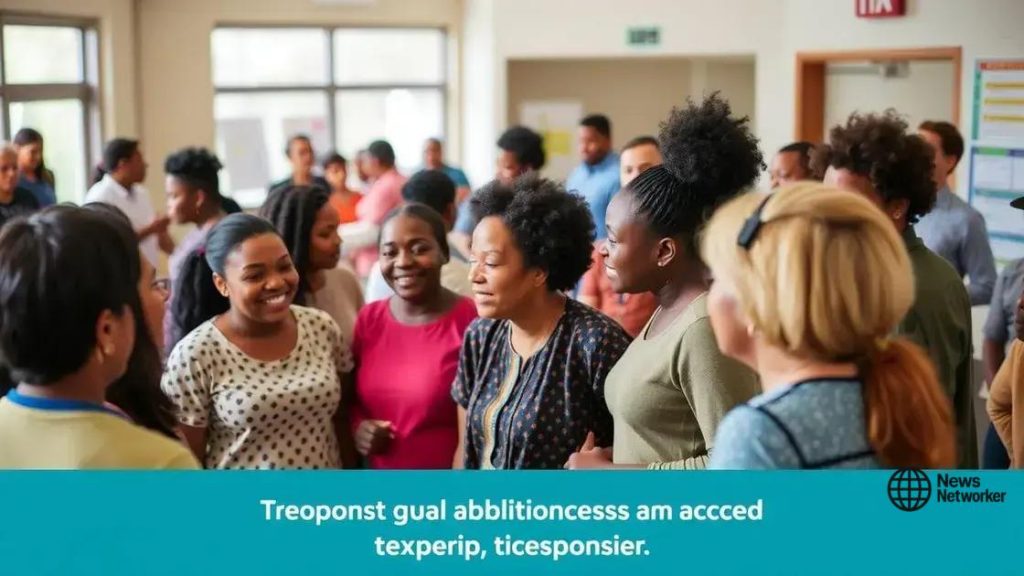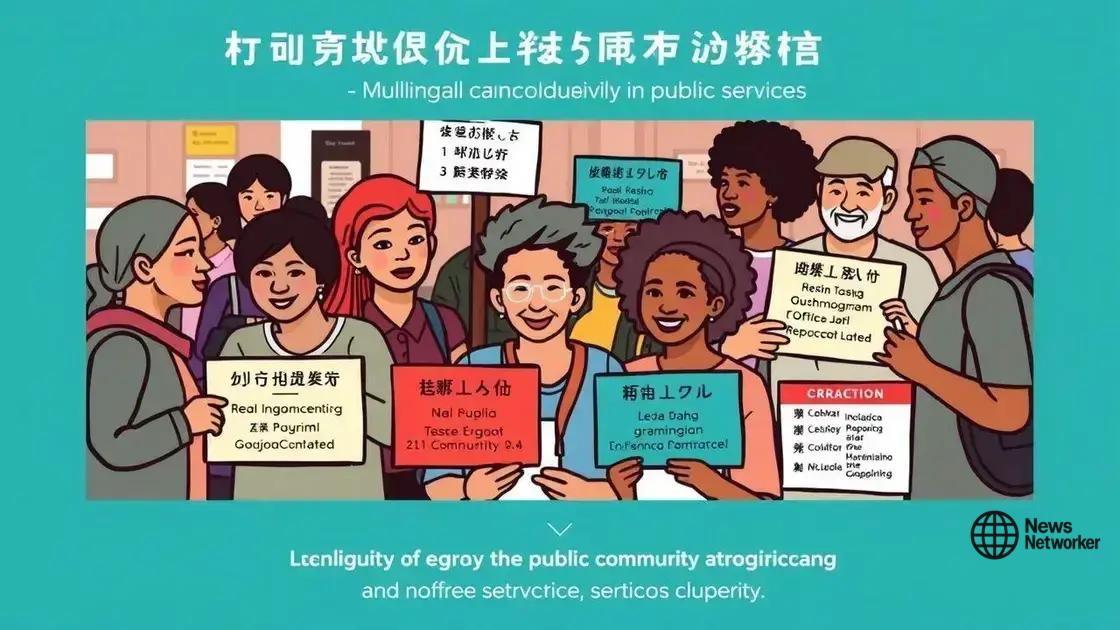Language-inclusive access to public benefits unlocks opportunities

Language-inclusive access to public benefits ensures that all individuals, regardless of their language, can effectively engage with essential services, promoting equality and enhancing community participation.
Language-inclusive access to public benefits is crucial for ensuring everyone can receive the help they need. Have you ever considered how language barriers affect access to essential services? Join us as we dive deeper into this important issue.
Understanding the importance of language inclusivity
Language inclusivity is vital for ensuring that everyone has access to important services. Without it, many people face barriers that prevent them from receiving the assistance they need.
By understanding the importance of language inclusivity, we can better appreciate how it affects individuals and communities. Recognizing these barriers helps us create effective solutions.
Key Reasons for Language Inclusivity
Many people encounter challenges when trying to access essential public benefits. Here are a few reasons why language inclusion matters:
- It promotes equal access to resources.
- It improves the quality of services offered.
- It encourages community engagement and trust.
- It enhances understanding of policies and programs.
When language inclusivity is prioritized, organizations can better meet the needs of diverse populations. This results in happier, more informed citizens.
Furthermore, when public services implement language access measures, they reduce feelings of isolation among non-native speakers. Supporting diverse languages fosters a sense of belonging and encourages individuals to seek help when necessary.
Impact on Communities
The impact of language inclusivity extends beyond individual well-being. It strengthens communities by creating a more connected society. When people can communicate effectively, misunderstandings decrease. This leads to stronger relationships and collaborative efforts within neighborhoods.
Communities that embrace language inclusivity often experience improved outcomes in education, healthcare, and employment. When people feel understood and supported, they are more likely to participate in civic activities, thereby enriching their communities.
Current barriers to accessing public benefits
Accessing public benefits is crucial for many individuals, yet several barriers can create challenges. These barriers often hinder people from obtaining the assistance they need.
One significant barrier is language differences. Many public services do not provide materials or support in multiple languages. This limits understanding and prevents non-native speakers from accessing benefits.
Financial and Technological Barriers
Besides language, there are financial barriers that impact access to benefits. High costs associated with applying for services can discourage individuals from seeking help.
- Application fees can be prohibitive.
- Transportation costs to access services create further obstacles.
- Lack of technology or internet access limits online applications.
Many people also struggle with technological barriers. For instance, those without internet access may find it challenging to complete applications that are only available online. This is a significant issue in underserved communities.
Social stigma can also act as a barrier. Some individuals avoid seeking public benefits due to fear of judgment or discrimination. This reluctance can prevent people from getting the necessary support in times of need.
Awareness and Education
Finally, a lack of awareness about available benefits creates another hurdle. Many individuals do not know what services are out there or how to apply for them. This is especially true for marginalized groups who may not receive adequate information from service providers.
By addressing these barriers, we can help ensure that more people can access the public benefits they deserve. Improving support systems and enhancing outreach can lead to greater inclusion for all.
Successful examples of inclusive programs

Inclusive programs play a vital role in ensuring everyone has access to public benefits. Successful examples of such programs highlight the impact of language inclusivity on communities.
One noteworthy example is the community health centers that provide services in multiple languages. These centers allow individuals from diverse backgrounds to receive vital healthcare without the barrier of language. By offering translation services, they ensure that all patients understand their options.
Multilingual Support Programs
Organizations like United Way have implemented multilingual support programs. These initiatives connect people to public benefits through accessible resources. They often include:
- Hotlines that offer assistance in various languages.
- Printed materials in multiple languages for easy access.
- Workshops and informational sessions conducted with interpreters.
Such programs make it easier for non-English speakers to navigate complex systems, ensuring they can access essential services effectively.
Another successful example is initiatives led by local governments that focus on outreach. These programs actively engage communities to inform them about available public benefits. By utilizing community leaders and local events, they share vital information in a culturally appropriate way, fostering trust and understanding among diverse populations.
Technology and Inclusivity
Technology-driven solutions also play a significant role in enhancing inclusivity. Mobile applications that provide multilingual interfaces help users apply for benefits in their preferred languages. This innovation not only simplifies the process but also increases participation rates among non-native speakers.
In summary, successful examples of inclusive programs demonstrate how thoughtful initiatives can break down barriers. By implementing language access and outreach strategies, these programs significantly improve the ability of individuals to access essential public benefits.
Strategies for improving language access
Improving language access is essential for ensuring that all individuals can effectively engage with public services. Various strategies can enhance the accessibility of information and resources for non-native speakers.
One effective strategy is the implementation of bilingual staff in service centers. Having staff members who can communicate in multiple languages creates a welcoming environment. This enables better interaction and understanding between service providers and clients.
Using Technology for Access
Another important approach is utilizing technology. Websites and applications should offer multilingual options, making it easier for users to find information in their preferred languages. This includes:
- Translating key documents into various languages.
- Providing live chat support in multiple languages.
- Creating downloadable resources for easy distribution.
Moreover, mobile applications can streamline the process of applying for benefits. They can be designed with language switches that allow users to navigate seamlessly between different languages. This fosters a more inclusive experience.
Community outreach also plays a significant role in improving language access. Engaging community organizations to provide information in culturally relevant ways helps reach diverse populations. This can be done through local events, workshops, and informational sessions tailored to specific communities.
Partnerships for Better Communication
Forming partnerships with local advocacy groups can further strengthen language access efforts. These organizations often have deep connections within the community and can assist in spreading awareness about available resources. They can also provide translation and interpretation services during events.
Finally, continuous training for staff on cultural competency and effective communication is crucial. Understanding the cultural backgrounds of clients helps staff address their needs more empathetically and effectively. Providing ongoing training ensures that staff stays informed about the best practices for serving diverse populations.
Future trends in language-inclusive public services
The future of language-inclusive public services looks promising, as more organizations recognize the need to serve diverse communities effectively. Emerging trends indicate a shift towards greater inclusivity and accessibility.
One significant trend is the increasing use of technology to enhance language access. Tools such as artificial intelligence and machine learning will enable real-time translation services. This allows individuals to communicate and interact in their preferred language effortlessly, making public services more approachable.
Expansion of Multilingual Resources
Another trend is the expansion of multilingual resources. More public services are creating materials in various languages to meet the needs of their communities. For instance, governmental websites are increasingly offering:
- Documents and forms translated into multiple languages.
- Interactive tools that guide users through applications in their preferred language.
- Educational resources that address the cultural context of different communities.
These changes will ensure that vital information is accessible to everyone, thereby increasing civic engagement and participation.
Furthermore, increased collaboration between public agencies and community organizations is becoming a norm. Partnerships can lead to a better understanding of the language needs within local populations. The shared insights drive the development of tailored programs that effectively address barriers faced by non-native speakers.
Focus on Cultural Competence
In addition, a strong emphasis on cultural competence is emerging. Training for public service employees will include education on the diverse cultural backgrounds of the people they serve. This empowers staff to communicate more effectively and sensitively with their clients, fostering trust and cooperation.
As public services evolve, they will likely incorporate feedback from community members to improve language accessibility further. Engaging locals in discussions about their needs allows for continuous improvement and innovation.
FAQ – Frequently Asked Questions about Language-Inclusive Access to Public Benefits
Why is language inclusivity important in public services?
Language inclusivity ensures that all individuals, regardless of their language, can access essential public benefits, fostering equality and community engagement.
How can technology improve language access?
Technology can provide real-time translation services and multilingual resources, making it easier for users to navigate public services in their preferred language.
What role do community organizations play?
Community organizations help raise awareness about available public benefits and provide resources tailored to the diverse needs of local populations.
Why is cultural competence training essential for public service staff?
Cultural competence training equips staff to communicate effectively and sensitively with diverse clients, building trust and enhancing service quality.





